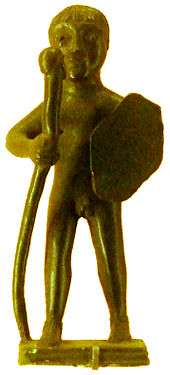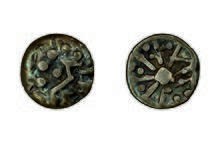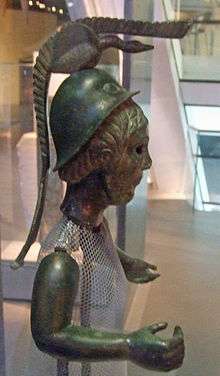Celts
The Celts (/kɛlts, sɛlts/, see pronunciation of Celt for different usages) are[1] a collection of Indo-European peoples[2] of Europe identified by their use of the Celtic languages and other cultural similarities.[3][4][5][6] The history of pre-Celtic Europe and the exact relationship between ethnic, linguistic and cultural factors in the Celtic world remains uncertain and controversial.[7] The exact geographic spread of the ancient Celts is disputed; in particular, the ways in which the Iron Age inhabitants of Great Britain and Ireland should be regarded as Celts have become a subject of controversy.[6][7][8][9] According to one theory, the common root of the Celtic languages, the Proto-Celtic language, arose in the Late Bronze Age Urnfield culture of Central Europe, which flourished from around 1200 BC.[10]
.jpg)

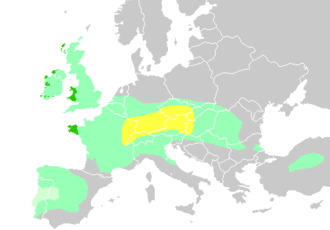
| Core Hallstatt territory, by the sixth century BC |
| Maximal Celtic expansion by 275 BC |
| Lusitanian area of Iberia where Celtic presence is uncertain |
| Areas where Celtic languages remain widely spoken today |
According to another theory proposed in the 19th century, the first people to adopt cultural characteristics regarded as Celtic were the people of the Iron Age Hallstatt culture in central Europe (c. 800–450 BC), named for the rich grave finds in Hallstatt, Austria.[10][11] It is thus that this area is sometimes called the "Celtic homeland". By or during the later La Tène period (c. 450 BC to the Roman conquest), named after the La Tène site in Switzerland, this Celtic culture was supposed to have expanded by trans-cultural diffusion or migration to the British Isles (Insular Celts), France and the Low Countries (Gauls), Bohemia, Poland and much of Central Europe, the Iberian Peninsula (Celtiberians, Celtici, Lusitanians and Gallaeci) and northern Italy (Golasecca culture and Cisalpine Gauls)[12] and, following the Celtic settlement of Eastern Europe beginning in 279 BC, as far east as central Anatolia (Galatians) in modern-day Turkey.[13]
The earliest undisputed direct examples of a Celtic language are the Lepontic inscriptions beginning in the 6th century BC.[14] Continental Celtic languages are attested almost exclusively through inscriptions and place-names. Insular Celtic languages are attested beginning around the 4th century in Ogham inscriptions, although they were clearly being spoken much earlier. Celtic literary tradition begins with Old Irish texts around the 8th century AD. Coherent texts of Early Irish literature, such as the Táin Bó Cúailnge ("Cattle Raid of Cooley"), survive in 12th-century recensions.
By the mid-1st millennium, with the expansion of the Roman Empire and migrating Germanic tribes, Celtic culture and Insular Celtic languages had become restricted to Ireland, the western and northern parts of Great Britain (Wales, Scotland, and Cornwall), the Isle of Man, and Brittany. Between the 5th and 8th centuries, the Celtic-speaking communities in these Atlantic regions emerged as a reasonably cohesive cultural entity. They had a common linguistic, religious and artistic heritage that distinguished them from the culture of the surrounding polities.[15] By the 6th century, however, the Continental Celtic languages were no longer in wide use.
Insular Celtic culture diversified into that of the Gaels (Irish, Scottish and Manx) and the Celtic Britons (Welsh, Cornish, and Bretons) of the medieval and modern periods.[3][16][17] A modern Celtic identity was constructed as part of the Romanticist Celtic Revival in Great Britain, Ireland, and other European territories, such as Portugal and Spanish Galicia.[18] Today, Irish, Scottish Gaelic, Welsh, and Breton are still spoken in parts of their historical territories, and Cornish and Manx are undergoing a revival.
Names and terminology

LLI·F(ilia)·CELTICA /
SUPERTAM(arica) /
(castello) MAIOBRI /
AN(norum)·XXV·
H(ic)·S(ita)·E(st) /
APANUS·FR(ater)·
F(aciendum)·C(uravit)"
The first recorded use of the name of Celts – as Κελτοί (Keltoi) in Greek – to refer to an ethnic group was by Hecataeus of Miletus, the Greek geographer, in 517 BC,[19] when writing about a people living near Massilia (modern Marseille).[20] In the fifth century BC, Herodotus referred to Keltoi living around the head of the Danube and also in the far west of Europe.[21] The etymology of the term Keltoi is unclear. Possible roots include Indo-European *kʲel 'to hide' (present also in Old Irish ceilid), IE *kʲel 'to heat' or *kel 'to impel'.[22] Several authors have supposed it to be Celtic in origin, while others view it as a name coined by Greeks. Linguist Patrizia De Bernardo Stempel falls in the latter group, and suggests the meaning "the tall ones".[23]
In the 1st century BC, Julius Caesar reported that the people known to the Romans as Gauls (Latin: Galli) called themselves Celts,[24] which suggests that even if the name Keltoi was bestowed by the Greeks, it had been adopted to some extent as a collective name by the tribes of Gaul. The geographer Strabo, writing about Gaul towards the end of the first century BC, refers to the "race which is now called both Gallic and Galatic," though he also uses the term Celtica as a synonym for Gaul, which is separated from Iberia by the Pyrenees. Yet he reports Celtic peoples in Iberia, and also uses the ethnic names Celtiberi and Celtici for peoples there, as distinct from Lusitani and Iberi.[25] Pliny the Elder cited the use of Celtici in Lusitania as a tribal surname,[26] which epigraphic findings have confirmed.[27][28]
Latin Gallus (pl. Galli) might stem from a Celtic ethnic or tribal name originally, perhaps one borrowed into Latin during the Celtic expansions into Italy during the early fifth century BC. Its root may be the Proto-Celtic *galno, meaning "power, strength", hence Old Irish gal "boldness, ferocity" and Welsh gallu "to be able, power". The tribal names of Gallaeci and the Greek Γαλάται (Galatai, Latinized Galatae; see the region Galatia in Anatolia) most probably have the same origin.[29] The suffix -atai might be an Ancient Greek inflection.[30] Classical writers did not apply the terms Κελτοί (Keltoi) or Celtae to the inhabitants of Britain or Ireland,[6][7][8] which has led to some scholars preferring not to use the term for the Iron Age inhabitants of those islands.[6][7][8][9]
Celt is a modern English word, first attested in 1707, in the writing of Edward Lhuyd, whose work, along with that of other late 17th-century scholars, brought academic attention to the languages and history of the early Celtic inhabitants of Great Britain.[31] The English form Gaul (first recorded in the 17th century) and Gaulish come from the French Gaule and Gaulois, a borrowing from Frankish *Walholant, "Roman land" (see Gaul: Name), the root of which is Proto-Germanic *walha-, "foreigner, Roman, Celt", whence the English word Welsh (Old English wælisċ < *walhiska-), South German welsch, meaning "Celtic speaker", "French speaker" or "Italian speaker" in different contexts, and Old Norse valskr, pl. valir, "Gaulish, French"). Proto-Germanic *walha is derived ultimately from the name of the Volcae,[32] a Celtic tribe who lived first in the south of Germany and in central Europe and then migrated to Gaul.[33] This means that English Gaul, despite its superficial similarity, is not actually derived from Latin Gallia (which should have produced **Jaille in French), though it does refer to the same ancient region.
Celtic refers to a family of languages and, more generally, means "of the Celts" or "in the style of the Celts". Several archaeological cultures are considered Celtic in nature, based on unique sets of artefacts. The link between language and artefact is aided by the presence of inscriptions.[34] The relatively modern idea of an identifiable Celtic cultural identity or "Celticity" generally focuses on similarities among languages, works of art, and classical texts,[35] and sometimes also among material artefacts, social organisation, homeland and mythology.[36] Earlier theories held that these similarities suggest a common racial origin for the various Celtic peoples, but more recent theories hold that they reflect a common cultural and language heritage more than a genetic one. Celtic cultures seem to have been widely diverse, with the use of a Celtic language being the main thing they had in common.[6]
Today, the term Celtic generally refers to the languages and respective cultures of Ireland, Scotland, Wales, Cornwall, the Isle of Man, and Brittany, also known as the Celtic nations. These are the regions where four Celtic languages are still spoken to some extent as mother tongues. The four are Irish Gaelic, Scottish Gaelic, Welsh, and Breton; plus two recent revivals, Cornish (one of the Brittonic languages) and Manx (one of the Goidelic languages). There are also attempts to reconstruct Cumbric, a Brittonic language from North West England and South West Scotland. Celtic regions of Continental Europe are those whose residents claim a Celtic heritage, but where no Celtic language has survived; these areas include the western Iberian Peninsula, i.e. Portugal and north-central Spain (Galicia, Asturias, Cantabria, Castile and León, Extremadura).[37]
Continental Celts are the Celtic-speaking people of mainland Europe and Insular Celts are the Celtic-speaking peoples of the British and Irish islands and their descendants. The Celts of Brittany derive their language from migrating insular Celts, mainly from Wales and Cornwall, and so are grouped accordingly.[38]
Origins
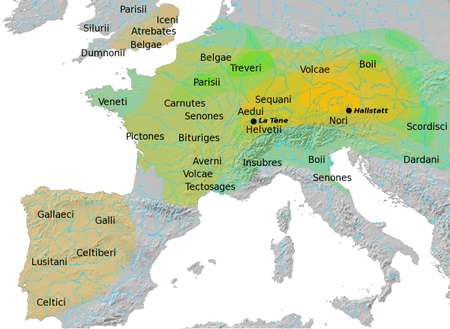

The Celtic languages form a branch of the larger Indo-European family. By the time speakers of Celtic languages entered history around 400 BC, they were already split into several language groups, and spread over much of Western continental Europe, the Iberian Peninsula, Ireland and Britain. The Greek historian Ephorus of Cyme in Asia Minor, writing in the 4th century BC, believed that the Celts came from the islands off the mouth of the Rhine and were "driven from their homes by the frequency of wars and the violent rising of the sea".
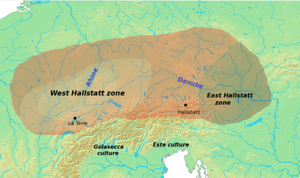 Map of the Hallstatt culture
Map of the Hallstatt culture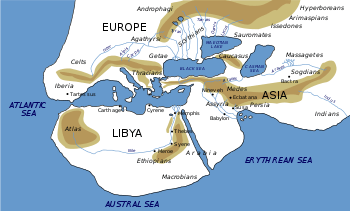 The world according to Herodotus
The world according to Herodotus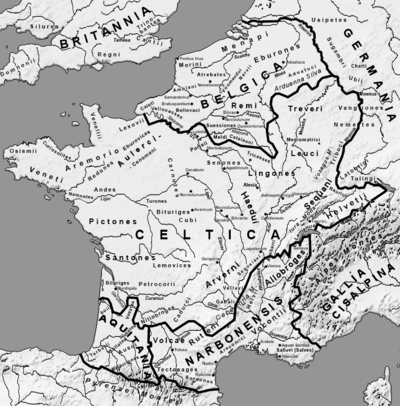 Borders of the region known as Celtica at time of the Roman conquest c. 54 BC; they soon renamed it Gallia Lugdunensis.
Borders of the region known as Celtica at time of the Roman conquest c. 54 BC; they soon renamed it Gallia Lugdunensis.
Hallstatt culture
Some scholars think that the Urnfield culture of western Middle Europe represents an origin for the Celts as a distinct cultural branch of the Indo-European family.[10] This culture was preeminent in central Europe during the late Bronze Age, from circa 1200 BC until 700 BC, itself following the Unetice and Tumulus cultures. The Urnfield period saw a dramatic increase in population in the region, probably due to innovations in technology and agriculture.
The spread of iron-working led to the development of the Hallstatt culture directly from the Urnfield (c. 700 to 500 BC). Proto-Celtic, the latest common ancestor of all known Celtic languages, is considered by this school of thought to have been spoken at the time of the late Urnfield or early Hallstatt cultures, in the early 1st millennium BC. The spread of the Celtic languages to Iberia, Ireland and Britain would have occurred during the first half of the 1st millennium BC, the earliest chariot burials in Britain dating to c. 500 BC. Other scholars see Celtic languages as covering Britain and Ireland, and parts of the Continent, long before any evidence of "Celtic" culture is found in archaeology. Over the centuries the language(s) developed into the separate Celtiberian, Goidelic and Brittonic languages.
The Hallstatt culture was succeeded by the La Tène culture of central Europe, which was overrun by the Roman Empire, though traces of La Tène style are still to be seen in Gallo-Roman artefacts. In Britain and Ireland La Tène style in art survived precariously to re-emerge in Insular art. Early Irish literature casts light on the flavour and tradition of the heroic warrior elites who dominated Celtic societies. Celtic river-names are found in great numbers around the upper reaches of the Danube and Rhine, which led many Celtic scholars to place the ethnogenesis of the Celts in this area.
Diodorus Siculus and Strabo both suggest that the heartland of the people they called Celts was in southern France. The former says that the Gauls were to the north of the Celts, but that the Romans referred to both as Gauls (in linguistic terms the Gauls were certainly Celts). Before the discoveries at Hallstatt and La Tène, it was generally considered that the Celtic heartland was southern France, see Encyclopædia Britannica for 1813.
Atlantic seaboard theory
Myles Dillon and Nora Kershaw Chadwick accepted that "the Celtic settlement of the British Isles" might have to be dated to the Bell Beaker culture concluding that "There is no reason why so early a date for the coming of the Celts should be impossible".[39][40] Martín Almagro Gorbea[41] proposed the origins of the Celts could be traced back to the 3rd millennium BC, also seeking the initial roots in the Beaker period, thus offering the wide dispersion of the Celts throughout western Europe, as well as the variability of the different Celtic peoples, and the existence of ancestral traditions and ancient perspective. Using a multidisciplinary approach, Alberto J. Lorrio and Gonzalo Ruiz Zapatero reviewed and built on Almagro Gorbea's work to present a model for the origin of the Celtic archaeological groups in the Iberian Peninsula (Celtiberian, Vetton, Vaccean, the Castro culture of the northwest, Asturian-Cantabrian and Celtic of the southwest) and proposing a rethinking of the meaning of "Celtic" from a European perspective.[42] More recently, John Koch[43] and Barry Cunliffe[44] have suggested that Celtic origins lie with the Atlantic Bronze Age, roughly contemporaneous with the Hallstatt culture but positioned considerably to the West, extending along the Atlantic coast of Europe.
Stephen Oppenheimer[45] points out that the only written evidence that locates the Keltoi near the source of the Danube (i.e. in the Hallstatt region) is in the Histories of Herodotus. However, Oppenheimer shows that Herodotus seemed to believe the Danube rose near the Pyrenees, which would place the Ancient Celts in a region which is more in agreement with later classical writers and historians (i.e. in Gaul and the Iberian peninsula).
Linguistic evidence
The Proto-Celtic language is usually dated to the Late Bronze Age.[10] The earliest records of a Celtic language are the Lepontic inscriptions of Cisalpine Gaul (Northern Italy), the oldest of which predate the La Tène period. Other early inscriptions, appearing from the early La Tène period in the area of Massilia, are in Gaulish, which was written in the Greek alphabet until the Roman conquest. Celtiberian inscriptions, using their own Iberian script, appear later, after about 200 BC. Evidence of Insular Celtic is available only from about 400 AD, in the form of Primitive Irish Ogham inscriptions.
Besides epigraphical evidence, an important source of information on early Celtic is toponymy.[46]
Genetic evidence
Historically many scholars postulated that there was genetic evidence of a common origin of the European Atlantic populations i.e.: Orkney Islands, Scottish, Irish, British, Bretons, and Iberians (Basques, Galicians).[47]
More recent genetic evidence does not support the notion of a significant genetic link between these populations, beyond the fact that they are all West Eurasians. Sardinian-like Neolithic farmers did populate Britain (and all of Northern Europe) during the Neolithic period, however, recent genetics research has claimed that, between 2400BC and 2000BC, over 90% of British DNA was overturned by a North European population of ultimate Russian Steppe origin as part of an ongoing migration process that brought large amounts of Steppe DNA (including the R1b haplogroup) to North and West Europe.[48] Modern autosomal genetic clustering is testament to this fact, as both modern and Iron Age British and Irish samples cluster genetically very closely with other North European populations, and somewhat limited with Galicians, Basques or those from the south of France.[49][50] Such findings have largely put to rest the theory that there is a significant ancestral genetic link (beyond being Europeans) between the various 'Celtic' peoples in the Atlantic area, instead, they are related in that male lines are brother R1b L151 subclades with the local native maternal line admixture explaining the genetic distance noted.
Archaeological evidence
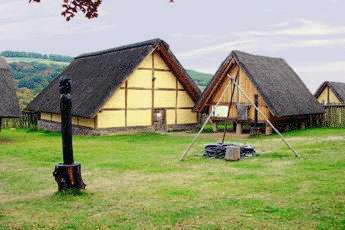
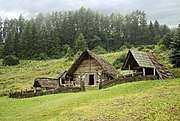
Before the 19th century, scholars assumed that the original land of the Celts was west of the Rhine, more precisely in Gaul, because it was where Greek and Roman ancient sources, namely Caesar, located the Celts. This view was challenged by the 19th-century historian Marie Henri d'Arbois de Jubainville who placed the land of origin of the Celts east of the Rhine. Jubainville based his arguments on a phrase of Herodotus' that placed the Celts at the source of the Danube, and argued that Herodotus had meant to place the Celtic homeland in southern Germany. The finding of the prehistoric cemetery of Hallstat in 1846 by Johan Ramsauer and the finding of the archaeological site of La Tène by Hansli Kopp in 1857 drew attention to this area.
The concept that the Hallstatt and La Tène cultures could be seen not just as chronological periods but as "Culture Groups", entities composed of people of the same ethnicity and language, had started to grow by the end of the 19th century. At the beginning of the 20th century the belief that these "Culture Groups" could be thought of in racial or ethnic terms was strongly held by Gordon Childe whose theory was influenced by the writings of Gustaf Kossinna.[51] As the 20th century progressed, the racial ethnic interpretation of La Tène culture became much more strongly rooted, and any findings of La Tène culture and flat inhumation cemeteries were directly associated with the Celts and the Celtic language.[52] The Iron Age Hallstatt (c. 800–475 BC) and La Tène (c. 500–50 BC) cultures are typically associated with Proto-Celtic and Celtic culture.[53]
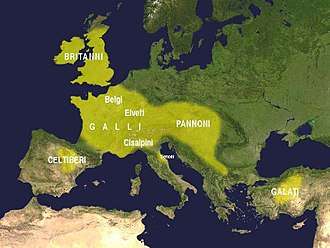
In various academic disciplines the Celts were considered a Central European Iron Age phenomenon, through the cultures of Hallstatt and La Tène. However, archaeological finds from the Halstatt and La Tène culture were rare in the Iberian Peninsula, in southwestern France, northern and western Britain, southern Ireland and Galatia[55][56] and did not provide enough evidence for a cultural scenario comparable to that of Central Europe. It is considered equally difficult to maintain that the origin of the Peninsular Celts can be linked to the preceding Urnfield culture. This has resulted in a more recent approach that introduces a 'proto-Celtic' substratum and a process of Celticisation, having its initial roots in the Bronze Age Bell Beaker culture.[57]
The La Tène culture developed and flourished during the late Iron Age (from 450 BC to the Roman conquest in the 1st century BC) in eastern France, Switzerland, Austria, southwest Germany, the Czech Republic, Slovakia and Hungary. It developed out of the Hallstatt culture without any definite cultural break, under the impetus of considerable Mediterranean influence from Greek, and later Etruscan civilisations. A shift of settlement centres took place in the 4th century.
The western La Tène culture corresponds to historical Celtic Gaul. Whether this means that the whole of La Tène culture can be attributed to a unified Celtic people is difficult to assess; archaeologists have repeatedly concluded that language, material culture, and political affiliation do not necessarily run parallel. Frey notes that in the 5th century, "burial customs in the Celtic world were not uniform; rather, localised groups had their own beliefs, which, in consequence, also gave rise to distinct artistic expressions".[58] Thus, while the La Tène culture is certainly associated with the Gauls, the presence of La Tène artefacts may be due to cultural contact and does not imply the permanent presence of Celtic speakers.
Historical evidence
Polybius published a history of Rome about 150 BC in which he describes the Gauls of Italy and their conflict with Rome. Pausanias in the 2nd century AD says that the Gauls "originally called Celts", "live on the remotest region of Europe on the coast of an enormous tidal sea". Posidonius described the southern Gauls about 100 BC. Though his original work is lost it was used by later writers such as Strabo. The latter, writing in the early 1st century AD, deals with Britain and Gaul as well as Hispania, Italy and Galatia. Caesar wrote extensively about his Gallic Wars in 58–51 BC. Diodorus Siculus wrote about the Celts of Gaul and Britain in his 1st-century history.
Distribution
Continental Celts
Gaul
The Romans knew the Celts then living in present-day France as Gauls. The territory of these peoples probably included the Low Countries, the Alps and present-day northern Italy. Julius Caesar in his Gallic Wars described the 1st-century BC descendants of those Gauls.
Eastern Gaul became the centre of the western La Tène culture. In later Iron Age Gaul, the social organisation resembled that of the Romans, with large towns. From the 3rd century BC the Gauls adopted coinage. Texts with Greek characters from southern Gaul have survived from the 2nd century BC.
Greek traders founded Massalia about 600 BC, with some objects (mostly drinking ceramics) being traded up the Rhone valley. But trade became disrupted soon after 500 BC and re-oriented over the Alps to the Po valley in the Italian peninsula. The Romans arrived in the Rhone valley in the 2nd century BC and encountered a mostly Celtic-speaking Gaul. Rome wanted land communications with its Iberian provinces and fought a major battle with the Saluvii at Entremont in 124–123 BC. Gradually Roman control extended, and the Roman Province of Gallia Transalpina developed along the Mediterranean coast.[59][60] The Romans knew the remainder of Gaul as Gallia Comata – "Hairy Gaul".
In 58 BC the Helvetii planned to migrate westward but Julius Caesar forced them back. He then became involved in fighting the various tribes in Gaul, and by 55 BC had overrun most of Gaul. In 52 BC Vercingetorix led a revolt against the Roman occupation but was defeated at the Siege of Alesia and surrendered.
Following the Gallic Wars of 58–51 BC, Caesar's Celtica formed the main part of Roman Gaul, becoming the province of Gallia Lugdunensis. This territory of the Celtic tribes was bounded on the south by the Garonne and on the north by the Seine and the Marne.[61] The Romans attached large swathes of this region to neighboring provinces Belgica and Aquitania, particularly under Augustus.
Place- and personal-name analysis and inscriptions suggest that the Gaulish Celtic language was spoken over most of what is now France.[62][63]
Iberia

Until the end of the 19th century, traditional scholarship dealing with the Celts did acknowledge their presence in the Iberian Peninsula[64][65] as a material culture relatable to the Hallstatt and La Tène cultures. However, since according to the definition of the Iron Age in the 19th century Celtic populations were supposedly rare in Iberia and did not provide a cultural scenario that could easily be linked to that of Central Europe, the presence of Celtic culture in that region was generally not fully recognised. Modern scholarship, however, has clearly proven that Celtic presence and influences were most substantial in what is today Spain and Portugal (with perhaps the highest settlement saturation in Western Europe), particularly in the central, western and northern regions.[66][67]
In addition to Gauls infiltrating from the north of the Pyrenees, the Roman and Greek sources mention Celtic populations in three parts of the Iberian Peninsula: the eastern part of the Meseta (inhabited by the Celtiberians), the southwest (Celtici, in modern-day Alentejo) and the northwest (Gallaecia and Asturias).[68] A modern scholarly review[69] found several archaeological groups of Celts in Spain:
- The Celtiberian group in the Upper-Douro Upper-Tagus Upper-Jalón area.[70] Archaeological data suggest a continuity at least from the 6th century BC. In this early period, the Celtiberians inhabited in hill-forts (Castros). Around the end of the 3rd century BC, Celtiberians adopted more urban ways of life. From the 2nd century BC, they minted coins and wrote inscriptions using the Celtiberian script. These inscriptions make the Celtiberian Language the only Hispano-Celtic language classified as Celtic with unanimous agreement.[71] In the late period, before the Roman Conquest, both archaeological evidence and Roman sources suggest that the Celtiberians were expanding into different areas in the Peninsula (e.g. Celtic Baeturia).
- The Vetton group in the western Meseta, between the Tormes, Douro and Tagus Rivers. They were characterised by the production of Verracos, sculptures of bulls and pigs carved in granite.
- The Vaccean group in the central Douro valley. They were mentioned by Roman sources already in the 220 BC. Some of their funerary rituals suggest strong influences from their Celtiberian neighbours.
- The Castro Culture in northwestern Iberia, modern day Galicia and Northern Portugal.[72] Its high degree of continuity, from the Late Bronze Age, makes it difficult to support that the introduction of Celtic elements was due to the same process of Celticization of the western Iberia, from the nucleus area of Celtiberia. Two typical elements are the sauna baths with monumental entrances, and the "Gallaecian Warriors", stone sculptures built in the 1st century AD. A large group of Latin inscriptions contain linguistic features that are clearly Celtic, while others are similar to those found in the non-Celtic Lusitanian language.[71]
- The Astures and the Cantabri. This area was romanised late, as it was not conquered by Rome until the Cantabrian Wars of 29–19 BC.
- Celts in the southwest, in the area Strabo called Celtica[73]
The origins of the Celtiberians might provide a key to understanding the Celticisation process in the rest of the Peninsula. The process of Celticisation of the southwestern area of the peninsula by the Keltoi and of the northwestern area is, however, not a simple Celtiberian question. Recent investigations about the Callaici[74] and Bracari[75] in northwestern Portugal are providing new approaches to understanding Celtic culture (language, art and religion) in western Iberia.[76]
John T. Koch of Aberystwyth University suggested that Tartessian inscriptions of the 8th century BC might be classified as Celtic. This would mean that Tartessian is the earliest attested trace of Celtic by a margin of more than a century.[77]
Alps and Italy
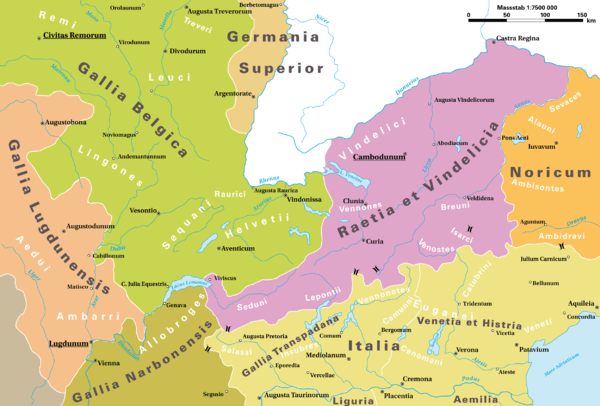
The Canegrate culture represented the first migratory wave of the proto-Celtic[78][79] population from the northwest part of the Alps that, through the Alpine passes, had already penetrated and settled in the western Po valley between Lake Maggiore and Lake Como (Scamozzina culture). It has also been proposed that a more ancient proto-Celtic presence can be traced back to the beginning of the Middle Bronze Age, when North Westwern Italy appears closely linked regarding the production of bronze artefacts, including ornaments, to the western groups of the Tumulus culture.[80] La Tène cultural material appeared over a large area of mainland Italy,[81] the southernmost example being the Celtic helmet from Canosa di Puglia.[82]
Italy is home to Lepontic, the oldest attested Celtic language (from the 6th century BC).[83] Anciently spoken in Switzerland and in Northern-Central Italy, from the Alps to Umbria.[84][85][86][87] According to the Recueil des Inscriptions Gauloises, more than 760 Gaulish inscriptions have been found throughout present-day France – with the notable exception of Aquitaine – and in Italy,[88][89] which testifies the importance of Celtic heritage in the peninsula.
In 391 BC, Celts "who had their homes beyond the Alps streamed through the passes in great strength and seized the territory that lay between the Apennine mountains and the Alps" according to Diodorus Siculus. The Po Valley and the rest of northern Italy (known to the Romans as Cisalpine Gaul) was inhabited by Celtic-speakers who founded cities such as Milan.[90] Later the Roman army was routed at the battle of Allia and Rome was sacked in 390 BC by the Senones.
At the battle of Telamon in 225 BC, a large Celtic army was trapped between two Roman forces and crushed.
The defeat of the combined Samnite, Celtic and Etruscan alliance by the Romans in the Third Samnite War sounded the beginning of the end of the Celtic domination in mainland Europe, but it was not until 192 BC that the Roman armies conquered the last remaining independent Celtic kingdoms in Italy.
Expansion east and south

The Celts also expanded down the Danube river and its tributaries. One of the most influential tribes, the Scordisci, had established their capital at Singidunum in the 3rd century BC, which is present-day Belgrade, Serbia. The concentration of hill-forts and cemeteries shows a density of population in the Tisza valley of modern-day Vojvodina, Serbia, Hungary and into Ukraine. Expansion into Romania was however blocked by the Dacians.
The Serdi were a Celtic tribe[91] inhabiting Thrace. They were located around and founded Serdika (Bulgarian: Сердика, Latin: Ulpia Serdica, Greek: Σαρδῶν πόλις), now Sofia in Bulgaria,[92] which reflects their ethnonym. They would have established themselves in this area during the Celtic migrations at the end of the 4th century BC, though there is no evidence for their existence before the 1st century BC. Serdi are among traditional tribal names reported into the Roman era.[93] They were gradually Thracianized over the centuries but retained their Celtic character in material culture up to a late date. According to other sources they may have been simply of Thracian origin,[94] according to others they may have become of mixed Thraco-Celtic origin. Further south, Celts settled in Thrace (Bulgaria), which they ruled for over a century, and Anatolia, where they settled as the Galatians (see also: Gallic Invasion of Greece). Despite their geographical isolation from the rest of the Celtic world, the Galatians maintained their Celtic language for at least 700 years. St Jerome, who visited Ancyra (modern-day Ankara) in 373 AD, likened their language to that of the Treveri of northern Gaul.
For Venceslas Kruta, Galatia in central Turkey was an area of dense Celtic settlement.
The Boii tribe gave their name to Bohemia, Bologna and possibly Bavaria, and Celtic artefacts and cemeteries have been discovered further east in what is now Poland and Slovakia. A Celtic coin (Biatec) from Bratislava's mint was displayed on the old Slovak 5-crown coin.
As there is no archaeological evidence for large-scale invasions in some of the other areas, one current school of thought holds that Celtic language and culture spread to those areas by contact rather than invasion.[95] However, the Celtic invasions of Italy and the expedition in Greece and western Anatolia, are well documented in Greek and Latin history.
There are records of Celtic mercenaries in Egypt serving the Ptolemies. Thousands were employed in 283–246 BC and they were also in service around 186 BC. They attempted to overthrow Ptolemy II.
Insular Celts
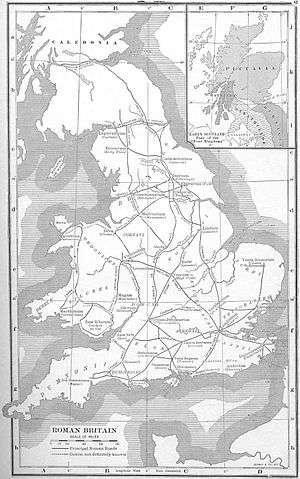
All Celtic languages extant today belong to the Insular Celtic languages, derived from the Celtic languages spoken in Iron Age Britain and Ireland.[96] They were separated into a Goidelic and a Brythonic branch from an early period.
Linguists have been arguing for many years whether a Celtic language came to Britain and Ireland and then split or whether there were two separate "invasions". The older view of prehistorians was that the Celtic influence in the British Isles was the result of successive invasions from the European continent by diverse Celtic-speaking peoples over the course of several centuries, accounting for the P-Celtic vs. Q-Celtic isogloss. This view has been challenged by the hypothesis that the Celtic languages of the British Isles form a phylogenetic Insular Celtic dialect group.[97]
In the 19th and 20th centuries, scholars commonly dated the "arrival" of Celtic culture in Britain (via an invasion model) to the 6th century BC, corresponding to archaeological evidence of Hallstatt influence and the appearance of chariot burials in what is now England. Some Iron Age migration does seem to have occurred but the nature of the interactions with the indigenous populations of the isles is unknown. According to this model, by about the 6th century (Sub-Roman Britain), most of the inhabitants of the Isles were speaking Celtic languages of either the Goidelic or the Brythonic branch. Since the late 20th century, a new model has emerged (championed by archaeologists such as Barry Cunliffe and Celtic historians such as John T. Koch) which places the emergence of Celtic culture in Britain much earlier, in the Bronze Age, and credits its spread not to invasion, but due to a gradual emergence in situ out of Proto-Indo-European culture (perhaps introduced to the region by the Bell Beaker People, and enabled by an extensive network of contacts that existed between the peoples of Britain and Ireland and those of the Atlantic seaboard.[98][99]
Classical writers did not apply the terms Κελτοί (Keltoi) or "Celtae" to the inhabitants of Britain or Ireland,[6][7][8] leading a number of scholars to question the use of the term Celt to describe the Iron Age inhabitants of those islands.[6][7][8][9] The first historical account of the islands of Britain and Ireland was by Pytheas, a Greek from the city of Massalia, who around 310–306 BC, sailed around what he called the "Pretannikai nesoi", which can be translated as the "Pretannic Isles".[100] In general, classical writers referred to the inhabitants of Britain as Pretannoi or Britanni.[101] Strabo, writing in the Roman era, clearly distinguished between the Celts and Britons.[102]
Romanisation
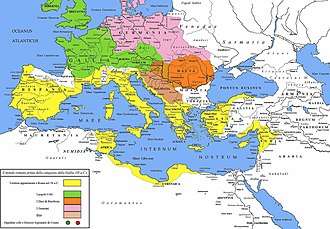
Under Caesar the Romans conquered Celtic Gaul, and from Claudius onward the Roman empire absorbed parts of Britain. Roman local government of these regions closely mirrored pre-Roman tribal boundaries, and archaeological finds suggest native involvement in local government.
The native peoples under Roman rule became Romanised and keen to adopt Roman ways. Celtic art had already incorporated classical influences, and surviving Gallo-Roman pieces interpret classical subjects or keep faith with old traditions despite a Roman overlay.
The Roman occupation of Gaul, and to a lesser extent of Britain, led to Roman-Celtic syncretism. In the case of the continental Celts, this eventually resulted in a language shift to Vulgar Latin, while the Insular Celts retained their language.
There was also considerable cultural influence exerted by Gaul on Rome, particularly in military matters and horsemanship, as the Gauls often served in the Roman cavalry. The Romans adopted the Celtic cavalry sword, the spatha, and Epona, the Celtic horse goddess.[103][104]
Society
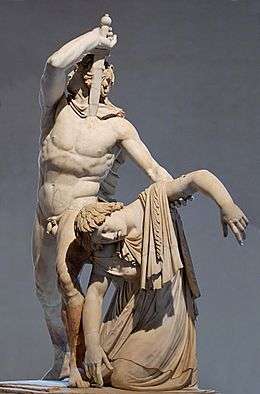
To the extent that sources are available, they depict a pre-Christian Iron Age Celtic social structure based formally on class and kingship, although this may only have been a particular late phase of organization in Celtic societies. Patron-client relationships similar to those of Roman society are also described by Caesar and others in the Gaul of the 1st century BC.
In the main, the evidence is of tribes being led by kings, although some argue that there is also evidence of oligarchical republican forms of government eventually emerging in areas which had close contact with Rome. Most descriptions of Celtic societies portray them as being divided into three groups: a warrior aristocracy; an intellectual class including professions such as druid, poet, and jurist; and everyone else. In historical times, the offices of high and low kings in Ireland and Scotland were filled by election under the system of tanistry, which eventually came into conflict with the feudal principle of primogeniture in which succession goes to the first-born son.
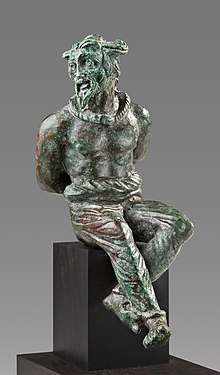

Little is known of family structure among the Celts. Patterns of settlement varied from decentralised to urban. The popular stereotype of non-urbanised societies settled in hillforts and duns,[105] drawn from Britain and Ireland (there are about 3,000 hill forts known in Britain)[106] contrasts with the urban settlements present in the core Hallstatt and La Tène areas, with the many significant oppida of Gaul late in the first millennium BC, and with the towns of Gallia Cisalpina.
Slavery, as practised by the Celts, was very likely similar to the better documented practice in ancient Greece and Rome.[107] Slaves were acquired from war, raids, and penal and debt servitude.[107] Slavery was hereditary, though manumission was possible. The Old Irish and Welsh words for 'slave', cacht and caeth respectively, are cognate with Latin captus 'captive' suggesting that the slave trade was an early means of contact between Latin and Celtic societies.[107] In the Middle Ages, slavery was especially prevalent in the Celtic countries.[108] Manumissions were discouraged by law and the word for "female slave", cumal, was used as a general unit of value in Ireland.[109]
Archaeological evidence suggests that the pre-Roman Celtic societies were linked to the network of overland trade routes that spanned Eurasia. Archaeologists have discovered large prehistoric trackways crossing bogs in Ireland and Germany. Due to their substantial nature, these are believed to have been created for wheeled transport as part of an extensive roadway system that facilitated trade.[110] The territory held by the Celts contained tin, lead, iron, silver and gold.[111] Celtic smiths and metalworkers created weapons and jewellery for international trade, particularly with the Romans.
The myth that the Celtic monetary system consisted of wholly barter is a common one, but is in part false. The monetary system was complex and is still not understood (much like the late Roman coinages), and due to the absence of large numbers of coin items, it is assumed that "proto-money" was used. This included bronze items made from the early La Tène period and onwards, which were often in the shape of axeheads, rings, or bells. Due to the large number of these present in some burials, it is thought they had a relatively high monetary value, and could be used for "day to day" purchases. Low-value coinages of potin, a bronze alloy with high tin content, were minted in most Celtic areas of the continent and in South-East Britain prior to the Roman conquest of these lands. Higher-value coinages, suitable for use in trade, were minted in gold, silver, and high-quality bronze. Gold coinage was much more common than silver coinage, despite being worth substantially more, as while there were around 100 mines in Southern Britain and Central France, silver was more rarely mined. This was due partly to the relative sparsity of mines and the amount of effort needed for extraction compared to the profit gained. As the Roman civilisation grew in importance and expanded its trade with the Celtic world, silver and bronze coinage became more common. This coincided with a major increase in gold production in Celtic areas to meet the Roman demand, due to the high value Romans put on the metal. The large number of gold mines in France is thought to be a major reason why Caesar invaded.
There are only very limited records from pre-Christian times written in Celtic languages. These are mostly inscriptions in the Roman and sometimes Greek alphabets. The Ogham script, an Early Medieval alphabet, was mostly used in early Christian times in Ireland and Scotland (but also in Wales and England), and was only used for ceremonial purposes such as inscriptions on gravestones. The available evidence is of a strong oral tradition, such as that preserved by bards in Ireland, and eventually recorded by monasteries. Celtic art also produced a great deal of intricate and beautiful metalwork, examples of which have been preserved by their distinctive burial rites.
In some regards the Atlantic Celts were conservative: for example, they still used chariots in combat long after they had been reduced to ceremonial roles by the Greeks and Romans. However, despite being outdated, Celtic chariot tactics were able to repel the invasion of Britain attempted by Julius Caesar.
According to Diodorus Siculus:
The Gauls are tall of body with rippling muscles and white of skin and their hair is blond, and not only naturally so for they also make it their practice by artificial means to increase the distinguishing colour which nature has given it. For they are always washing their hair in limewater and they pull it back from the forehead to the nape of the neck, with the result that their appearance is like that of Satyrs and Pans since the treatment of their hair makes it so heavy and coarse that it differs in no respect from the mane of horses. Some of them shave the beard but others let it grow a little; and the nobles shave their cheeks but they let the moustache grow until it covers the mouth.
Clothing
During the later Iron Age the Gauls generally wore long-sleeved shirts or tunics and long trousers (called braccae by the Romans).[112] Clothes were made of wool or linen, with some silk being used by the rich. Cloaks were worn in the winter. Brooches and armlets were used, but the most famous item of jewellery was the torc, a neck collar of metal, sometimes gold. The horned Waterloo Helmet in the British Museum, which long set the standard for modern images of Celtic warriors, is in fact a unique survival, and may have been a piece for ceremonial rather than military wear.
Gender and sexual norms
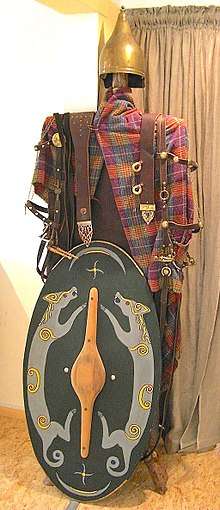
Very few reliable sources exist regarding Celtic views on gender divisions and societal status, though some archaeological evidence does suggest that their views of gender roles may differ from contemporary and less egalitarian classical counterparts of the Roman era.[113][114] There are some general indications from Iron Age burial sites in the Champagne and Bourgogne regions of Northeastern France suggesting that women may have had roles in combat during the earlier La Tène period. However, the evidence is far from conclusive.[115] Examples of individuals buried with both female jewellery and weaponry have been identified, such as the Vix Grave, and there are questions about the gender of some skeletons that were buried with warrior assemblages. However, it has been suggested that "the weapons may indicate rank instead of masculinity".[116]
Among the insular Celts, there is a greater amount of historic documentation to suggest warrior roles for women. In addition to commentary by Tacitus about Boudica, there are indications from later period histories that also suggest a more substantial role for "women as warriors", in symbolic if not actual roles. Posidonius and Strabo described an island of women where men could not venture for fear of death, and where the women ripped each other apart.[117] Other writers, such as Ammianus Marcellinus and Tacitus, mentioned Celtic women inciting, participating in, and leading battles.[118] Posidonius' anthropological comments on the Celts had common themes, primarily primitivism, extreme ferocity, cruel sacrificial practices, and the strength and courage of their women.[119]
Under Brehon Law, which was written down in early Medieval Ireland after conversion to Christianity, a woman had the right to divorce her husband and gain his property if he was unable to perform his marital duties due to impotence, obesity, homosexual inclination or preference for other women.[120]
Classical literature records the views of the Celts' neighbours, though historians are not sure how much relation to reality these had. According to Aristotle, most "belligerent nations" were strongly influenced by their women, but the Celts were unusual because their men openly preferred male lovers (Politics II 1269b).[121] H. D. Rankin in Celts and the Classical World notes that "Athenaeus echoes this comment (603a) and so does Ammianus (30.9). It seems to be the general opinion of antiquity."[122] In book XIII of his Deipnosophists, the Roman Greek rhetorician and grammarian Athenaeus, repeating assertions made by Diodorus Siculus in the 1st century BC (Bibliotheca historica 5:32), wrote that Celtic women were beautiful but that the men preferred to sleep together. Diodorus went further, stating that "the young men will offer themselves to strangers and are insulted if the offer is refused". Rankin argues that the ultimate source of these assertions is likely to be Posidonius and speculates that these authors may be recording male "bonding rituals".[123]
The sexual freedom of women in Britain was noted by Cassius Dio:
... a very witty remark is reported to have been made by the wife of Argentocoxus, a Caledonian, to Julia Augusta. When the empress was jesting with her, after the treaty, about the free intercourse of her sex with men in Britain, she replied: "We fulfill the demands of nature in a much better way than do you Roman women; for we consort openly with the best men, whereas you let yourselves be debauched in secret by the vilest." Such was the retort of the British woman.[124]
There are instances recorded where women participated both in warfare and in kingship, although they were in the minority in these areas. Plutarch reports that Celtic women acted as ambassadors to avoid a war among Celts chiefdoms in the Po valley during the 4th century BC.[125]
Celtic art
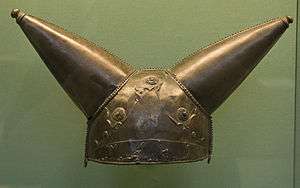
Celtic art is generally used by art historians to refer to art of the La Tène period across Europe, while the Early Medieval art of Britain and Ireland, that is what "Celtic art" evokes for much of the general public, is called Insular art in art history. Both styles absorbed considerable influences from non-Celtic sources, but retained a preference for geometrical decoration over figurative subjects, which are often extremely stylised when they do appear; narrative scenes only appear under outside influence. Energetic circular forms, triskeles and spirals are characteristic. Much of the surviving material is in precious metal, which no doubt gives a very unrepresentative picture, but apart from Pictish stones and the Insular high crosses, large monumental sculpture, even with decorative carving, is very rare; possibly it was originally common in wood. Celts were also able to create developed musical instruments such as the carnyces, these famous war trumpets used before the battle to frighten the enemy, as the best preserved found in Tintignac (Gaul) in 2004 and which were decorated with a boar head or a snake head.[126]
The interlace patterns that are often regarded as typical of "Celtic art" were characteristic of the whole of the British Isles, a style referred to as Insular art, or Hiberno-Saxon art. This artistic style incorporated elements of La Tène, Late Roman, and, most importantly, animal Style II of Germanic Migration Period art. The style was taken up with great skill and enthusiasm by Celtic artists in metalwork and illuminated manuscripts. Equally, the forms used for the finest Insular art were all adopted from the Roman world: Gospel books like the Book of Kells and Book of Lindisfarne, chalices like the Ardagh Chalice and Derrynaflan Chalice, and penannular brooches like the Tara Brooch. These works are from the period of peak achievement of Insular art, which lasted from the 7th to the 9th centuries, before the Viking attacks sharply set back cultural life.
In contrast the less well known but often spectacular art of the richest earlier Continental Celts, before they were conquered by the Romans, often adopted elements of Roman, Greek and other "foreign" styles (and possibly used imported craftsmen) to decorate objects that were distinctively Celtic. After the Roman conquests, some Celtic elements remained in popular art, especially Ancient Roman pottery, of which Gaul was actually the largest producer, mostly in Italian styles, but also producing work in local taste, including figurines of deities and wares painted with animals and other subjects in highly formalised styles. Roman Britain also took more interest in enamel than most of the Empire, and its development of champlevé technique was probably important to the later Medieval art of the whole of Europe, of which the energy and freedom of Insular decoration was an important element. Rising nationalism brought Celtic revivals from the 19th century.
Warfare and weapons

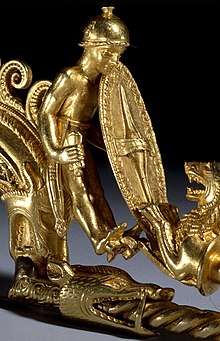
Tribal warfare appears to have been a regular feature of Celtic societies. While epic literature depicts this as more of a sport focused on raids and hunting rather than organised territorial conquest, the historical record is more of tribes using warfare to exert political control and harass rivals, for economic advantage, and in some instances to conquer territory.
The Celts were described by classical writers such as Strabo, Livy, Pausanias, and Florus as fighting like "wild beasts", and as hordes. Dionysius said that their
"manner of fighting, being in large measure that of wild beasts and frenzied, was an erratic procedure, quite lacking in military science. Thus, at one moment they would raise their swords aloft and smite after the manner of wild boars, throwing the whole weight of their bodies into the blow like hewers of wood or men digging with mattocks, and again they would deliver crosswise blows aimed at no target, as if they intended to cut to pieces the entire bodies of their adversaries, protective armour and all".[127]
Such descriptions have been challenged by contemporary historians.[128]
Polybius (2.33) indicates that the principal Celtic weapon was a long bladed sword which was used for hacking edgewise rather than stabbing. Celtic warriors are described by Polybius and Plutarch as frequently having to cease fighting in order to straighten their sword blades. This claim has been questioned by some archaeologists, who note that Noric steel, steel produced in Celtic Noricum, was famous in the Roman Empire period and was used to equip the Roman military.[129][130] However, Radomir Pleiner, in The Celtic Sword (1993) argues that "the metallographic evidence shows that Polybius was right up to a point", as around one third of surviving swords from the period might well have behaved as he describes.[131]
Polybius also asserts that certain of the Celts fought naked, "The appearance of these naked warriors was a terrifying spectacle, for they were all men of splendid physique and in the prime of life."[132] According to Livy, this was also true of the Celts of Asia Minor.[133]
Head hunting
Celts had a reputation as head hunters. According to Paul Jacobsthal, "Amongst the Celts the human head was venerated above all else, since the head was to the Celt the soul, centre of the emotions as well as of life itself, a symbol of divinity and of the powers of the other-world."[134] Arguments for a Celtic cult of the severed head include the many sculptured representations of severed heads in La Tène carvings, and the surviving Celtic mythology, which is full of stories of the severed heads of heroes and the saints who carry their own severed heads, right down to Sir Gawain and the Green Knight, where the Green Knight picks up his own severed head after Gawain has struck it off, just as St. Denis carried his head to the top of Montmartre. Physical evidence exists for the ritual importance of the severed head at the religious centre at Roquepertuse (southern France), destroyed by the Romans in 124 BC, where stone pillars with prominent niches for displaying severed heads were found.
A further example of this regeneration after beheading lies in the tales of Connemara's St. Feichin, who after being beheaded by Viking pirates carried his head to the Holy Well on Omey Island and on dipping the head into the well placed it back upon his neck and was restored to full health.
Diodorus Siculus, in his 1st-century History had this to say about Celtic head-hunting:
They cut off the heads of enemies slain in battle and attach them to the necks of their horses. The blood-stained spoils they hand over to their attendants and striking up a paean and singing a song of victory; and they nail up these first fruits upon their houses, just as do those who lay low wild animals in certain kinds of hunting. They embalm in cedar oil the heads of the most distinguished enemies, and preserve them carefully in a chest, and display them with pride to strangers, saying that for this head one of their ancestors, or his father, or the man himself, refused the offer of a large sum of money. They say that some of them boast that they refused the weight of the head in gold.
In Gods and Fighting Men, Lady Gregory's Celtic Revival translation of Irish mythology, heads of men killed in battle are described in the beginning of the story The Fight with the Fir Bolgs as pleasing to Macha, one aspect of the war goddess Morrigu.
Religion
Polytheism
Like other European Iron Age tribal societies, the Celts practised a polytheistic religion.[135] Many Celtic gods are known from texts and inscriptions from the Roman period. Rites and sacrifices were carried out by priests known as druids. The Celts did not see their gods as having human shapes until late in the Iron Age. Celtic shrines were situated in remote areas such as hilltops, groves, and lakes.
Celtic religious patterns were regionally variable; however, some patterns of deity forms, and ways of worshipping these deities, appeared over a wide geographical and temporal range. The Celts worshipped both gods and goddesses. In general, Celtic gods were deities of particular skills, such as the many-skilled Lugh and Dagda, while goddesses were associated with natural features, particularly rivers (such as Boann, goddess of the River Boyne). This was not universal, however, as goddesses such as Brighid and The Morrígan were associated with both natural features (holy wells and the River Unius) and skills such as blacksmithing and healing.[136]
Triplicity is a common theme in Celtic cosmology, and a number of deities were seen as threefold.[137] This trait is exhibited by The Three Mothers, a group of goddesses worshipped by many Celtic tribes (with regional variations).[138]
The Celts had hundreds of deities, some of which were unknown outside a single family or tribe, while others were popular enough to have a following that crossed lingual and cultural barriers. For instance, the Irish god Lugh, associated with storms, lightning, and culture, is seen in similar forms as Lugos in Gaul and Lleu in Wales. Similar patterns are also seen with the continental Celtic horse goddess Epona and what may well be her Irish and Welsh counterparts, Macha and Rhiannon, respectively.[139]
Roman reports of the druids mention ceremonies being held in sacred groves. La Tène Celts built temples of varying size and shape, though they also maintained shrines at sacred trees and votive pools.[135]
Druids fulfilled a variety of roles in Celtic religion, serving as priests and religious officiants, but also as judges, sacrificers, teachers, and lore-keepers. Druids organised and ran religious ceremonies, and they memorised and taught the calendar. Other classes of druids performed ceremonial sacrifices of crops and animals for the perceived benefit of the community.[140]
Gallic calendar
The Coligny calendar, which was found in 1897 in Coligny, Ain, was engraved on a bronze tablet, preserved in 73 fragments, that originally was 1.48 metres (4 feet 10 inches) wide and 0.9 metres (2 feet 11 inches) high (Lambert p. 111). Based on the style of lettering and the accompanying objects, it probably dates to the end of the 2nd century.[141] It is written in Latin inscriptional capitals, and is in the Gallic language. The restored tablet contains 16 vertical columns, with 62 months distributed over 5 years.
The French archaeologist J. Monard speculated that it was recorded by druids wishing to preserve their tradition of timekeeping in a time when the Julian calendar was imposed throughout the Roman Empire. However, the general form of the calendar suggests the public peg calendars (or parapegmata) found throughout the Greek and Roman world.[142]
Roman influence
The Roman invasion of Gaul brought a great deal of Celtic peoples into the Roman Empire. Roman culture had a profound effect on the Celtic tribes which came under the empire's control. Roman influence led to many changes in Celtic religion, the most noticeable of which was the weakening of the druid class, especially religiously; the druids were to eventually disappear altogether. Romano-Celtic deities also began to appear: these deities often had both Roman and Celtic attributes, combined the names of Roman and Celtic deities, and/or included couples with one Roman and one Celtic deity. Other changes included the adaptation of the Jupiter Column, a sacred column set up in many Celtic regions of the empire, primarily in northern and eastern Gaul. Another major change in religious practice was the use of stone monuments to represent gods and goddesses. The Celts had only created wooden idols (including monuments carved into trees, which were known as sacred poles) previously to Roman conquest.[138]
Celtic Christianity
While the regions under Roman rule adopted Christianity along with the rest of the Roman empire, unconquered areas of Ireland and Scotland began to move from Celtic polytheism to Christianity in the 5th century. Ireland was converted by missionaries from Britain, such as Saint Patrick. Later missionaries from Ireland were a major source of missionary work in Scotland, Anglo-Saxon parts of Britain, and central Europe (see Hiberno-Scottish mission). Celtic Christianity, the forms of Christianity that took hold in Britain and Ireland at this time, had for some centuries only limited and intermittent contact with Rome and continental Christianity, as well as some contacts with Coptic Christianity. Some elements of Celtic Christianity developed, or retained, features that made them distinct from the rest of Western Christianity, most famously their conservative method of calculating the date of Easter. In 664, the Synod of Whitby began to resolve these differences, mostly by adopting the current Roman practices, which the Gregorian Mission from Rome had introduced to Anglo-Saxon England.
Genetics
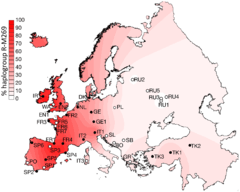
Genetic studies on the limited amount of material available suggest continuity between Iron Age people from areas considered Celtic and the earlier Bell Beaker culture of Bronze Age Western Europe.[146][147] Like the Bell Beakers, ancient Celts carried a substantial amount of steppe ancestry, which is derived from pastoralists who expanded westwards from the Pontic-Caspian steppe during late Neolithic and early Bronze Age.[148] Examined individuals overwhelmingly carry types of the paternal haplogroup R-M269,[143][144][145] while the maternal haplogroups H and U are frequent.[149] These lineages are associated with steppe ancestry.[143][149] The spread of Celts into Iberia and the emergence of the Celtiberians is associated with an increase in north-central European ancestry in Iberia, and may be connected to the expansion of the Urnfield culture.[150] The paternal haplogroup haplogroup I2a1a1a has been detected among Celtiberians.[151] There appears to have been significant gene flow between among Celts of Western Europe during the Iron Age.[152] Modern populations of Western Europe, particularly those who still speak Celtic languages, display substantial genetic continuity with the Iron Age populations of the same areas.[153][154]
References
- Waldman & Mason 2006, p. 144. "CELTS location: Greater Europe time period: Second millennium B.C.E. to present ancestry: Celtic
- Mac Cana & Dillon. "The Celts, an ancient Indo-European people, reached the apogee of their influence and territorial expansion during the 4th century bc, extending across the length of Europe from Britain to Asia Minor."; Puhvel, Fee & Leeming 2003, p. 67. "[T]he Celts, were Indo-Europeans, a fact that explains a certain compatibility between Celtic, Roman, and Germanic mythology."; Riché 2005, p. 150. "The Celts and Germans were two Indo-European groups whose civilizations had some common characteristics."; Todd 1975, p. 42. "Celts and Germans were of course derived from the same Indo-European stock."; Encyclopedia Britannica. Celt. "Celt, also spelled Kelt, Latin Celta, plural Celtae, a member of an early Indo-European people who from the 2nd millennium bce to the 1st century bce spread over much of Europe.";
- Drinkwater 2012, p. 295. "Celts, a name applied by ancient writers to a population group occupying lands mainly north of the Mediterranean region from Galicia in the west to Galatia in the east. (Its application to the Welsh, the Scots, and the Irish is modern.) Their unity is recognizable by common speech and common artistic traditions.
- Waldman & Mason 2006, p. 144. "Celts, in its modern usage, is an encompassing term referring to all Celtic-speaking peoples."
- Encyclopedia Britannica. Celt. "Celt, also spelled Kelt, Latin Celta, plural Celtae, a member of an early Indo-European people who from the 2nd millennium bce to the 1st century bce spread over much of Europe. Their tribes and groups eventually ranged from the British Isles and northern Spain to as far east as Transylvania, the Black Sea coasts, and Galatia in Anatolia and were in part absorbed into the Roman Empire as Britons, Gauls, Boii, Galatians, and Celtiberians. Linguistically they survive in the modern Celtic speakers of Ireland, Highland Scotland, the Isle of Man, Wales, and Brittany.
- Koch, John (2005). Celtic Culture: a historical encyclopedia. Santa Barbara: ABC-CLIO. p. xix–xxi. ISBN 978-1-85109-440-0. Retrieved 9 June 2010.
This Encyclopedia is designed for the use of everyone interested in Celtic studies and also for those interested in many related and subsidiary fields, including the individual CELTIC COUNTRIES and their languages, literatures, archaeology, folklore, and mythology. In its chronological scope, the Encyclopedia covers subjects from the HALLSTATT and LA TENE periods of the later pre-Roman Iron Age to the beginning of the 21st century.
- James, Simon (1999). The Atlantic Celts – Ancient People Or Modern Invention. University of Wisconsin Press.
- Collis, John (2003). The Celts: Origins, Myths and Inventions. Stroud: Tempus Publishing. ISBN 978-0-7524-2913-7.
- Pryor, Francis (2004). Britain BC. Harper Perennial. ISBN 978-0007126934.
- Chadwick, Nora; Corcoran, J. X. W. P. (1970). The Celts. Penguin Books. pp. 28–33.
- Cunliffe, Barry (1997). The Ancient Celts. Penguin Books. pp. 39–67.
- Koch, John T (2010). Celtic from the West Chapter 9: Paradigm Shift? Interpreting Tartessian as Celtic – see map 9.3 The Ancient Celtic Languages c. 440/430 BC – see third map in PDF at URL provided which is essentially the same map (PDF). Oxbow Books, Oxford, UK. p. 193. ISBN 978-1-84217-410-4. Archived (PDF) from the original on 9 July 2012.
- Koch, John T (2010). Celtic from the West Chapter 9: Paradigm Shift? Interpreting Tartessian as Celtic – see map 9.2 Celtic expansion from Hallstatt/La Tene central Europe – see second map in PDF at URL provided which is essentially the same map (PDF). Oxbow Books, Oxford, UK. p. 190. ISBN 978-1-84217-410-4. Archived (PDF) from the original on 9 July 2012.
- Stifter, David (2008). Old Celtic Languages (PDF). pp. 24–37. Archived (PDF) from the original on 30 June 2011.
- Cunliffe, Barry (2003). The Celts – a very short introduction. Oxford University Press. p. 109. ISBN 978-0-19-280418-1.
- Minahan, James (2000). One Europe, Many Nations: A Historical Dictionary of European National Groups. Greenwood Publishing Group. p. 179. ISBN 978-0313309847.
The Cornish are related to the other Celtic peoples of Europe, the Bretons,* Irish,* Scots,* Manx,* Welsh,* and the Galicians* of northwestern Spain
- Minahan, James (2000). One Europe, Many Nations: A Historical Dictionary of European National Groups. Greenwood Publishing Group. p. 766. ISBN 978-0313309847.
Celts, 257, 278, 523, 533, 555, 643; Bretons, 129–33; Cornish, 178–81; Galicians, 277–80; Irish, 330–37; Manx, 452–55; Scots, 607–12; Welsh
- McKevitt, Kerry Ann (2006). "Mythologizing Identity and History: a look at the Celtic past of Galicia" (PDF). E-Keltoi. 6: 651–73. Archived from the original (PDF) on 24 June 2011. Retrieved 8 April 2011.
- Sarunas Milisauskas, European prehistory: a survey. Springer. 2002. p. 363. ISBN 978-0-306-47257-2. Retrieved 7 June 2010.
- H. D. Rankin, Celts and the classical world. Routledge. 1998. pp. 1–2. ISBN 978-0-415-15090-3. Retrieved 7 June 2010.
- Herodotus, The Histories, 2.33; 4.49.
- John T. Koch (ed.), Celtic Culture: a historical encyclopedia. 5 vols. 2006. Santa Barbara, California: ABC-CLIO, p. 371.
- P. De Bernardo Stempel 2008. "Linguistically Celtic ethnonyms: towards a classification", in Celtic and Other Languages in Ancient Europe, J. L. García Alonso (ed.), 101–18. Ediciones Universidad Salamanca.
- Julius Caesar, Commentarii de Bello Gallico 1.1: "All Gaul is divided into three parts, one of which the Belgae live, another in which the Aquitani live, and the third are those who in their own tongue are called Celtae, in our language Galli."
- Strabo, Geography, 3.1.3; 3.1.6; 3.2.2; 3.2.15; 4.4.2.
- Pliny the Elder, The Natural History 21: "the Mirobrigenses, surnamed Celtici" ("Mirobrigenses qui Celtici cognominantur").
- "Archived copy" (PDF). Archived from the original (PDF) on 11 October 2017. Retrieved 9 June 2013.CS1 maint: archived copy as title (link)
- Fernando De Almeida, Breve noticia sobre o santuário campestre romano de Miróbriga dos Celticos (Portugal): D(IS) M(ANIBUS) S(ACRUM) / C(AIUS) PORCIUS SEVE/RUS MIROBRIGEN(SIS) / CELT(ICUS) ANN(ORUM) LX / H(IC) S(ITUS) E(ST) S(IT) T(IBI) T(ERRA) L(EVIS).
- Koch, John Thomas (2006). Celtic culture: a historical encyclopedia. ABC-CLIO. pp. 794–95. ISBN 978-1-85109-440-0.
- Spencer and Zwicky, Andrew and Arnold M (1998). The handbook of morphology. Blackwell Publishers. p. 148. ISBN 978-0-631-18544-4.
- Lhuyd, E. Archaeologia Britannica; An account of the languages, histories, and customs of the original inhabitants of Great Britain. (reprint ed.) Irish University Press, 1971, p. 290. ISBN 0-7165-0031-0.
- Koch, John Thomas (2006). Celtic culture: a historical encyclopedia. ABC-CLIO. p. 532. ISBN 978-1-85109-440-0.
- Mountain, Harry (1998). The Celtic Encyclopedia, Volume 1. uPublish.com. p. 252. ISBN 978-1-58112-889-5.
- Kruta, Venceslas; et al. (1991). The Celts. Thames and Hudson. pp. 95–102.
- Paul Graves-Brown, Siân Jones, Clive Gamble, Cultural identity and archaeology: the construction of European communities, pp. 242–244. Routledge. 1996. ISBN 978-0-415-10676-4. Retrieved 7 June 2010.
- Carl McColman, The Complete Idiot's Guide to Celtic Wisdom. Alpha Books. 2003. pp. 31–34. ISBN 978-0-02-864417-2. Retrieved 7 June 2010.
- Monaghan, Patricia (2008). The Encyclopedia of Celtic Mythology and Folklore. Facts on File Inc. ISBN 978-0-8160-7556-0.
- Chadwick, Nora (1970). The Celts with an introductory chapter by J.X.W.P. Corcoran. Penguin Books. p. 81.
- Myles Dillon and Nora Kershaw Chadwick, The Celtic Realms, 1967, 18–19
- Cunliffe, Barry (2010). Celtic from the West Chapter 1: Celticization from the West – The Contribution of Archaeology. Oxbow Books, Oxford, UK. p. 14. ISBN 978-1-84217-410-4.
- 2001 p 95. La lengua de los Celtas y otros pueblos indoeuropeos de la península ibérica. In Almagro-Gorbea, M., Mariné, M. and Álvarez-Sanchís, J.R. (eds) Celtas y Vettones, pp. 115–21. Ávila: Diputación Provincial de Ávila.
- Lorrio and Ruiz Zapatero, Alberto J. and Gonzalo (2005). "The Celts in Iberia: An Overview". E-Keltoi. 6 : The Celts in the Iberian Peninsula: 167–254. Archived from the original on 24 June 2011. Retrieved 12 August 2010.
- Koch, John (2009). Tartessian: Celtic from the Southwest at the Dawn of History in Acta Palaeohispanica X Palaeohispanica 9 (PDF). Palaeohispanica. pp. 339–51. ISSN 1578-5386. Archived (PDF) from the original on 23 June 2010. Retrieved 17 May 2010.
- Cunliffe, Barry (2008). A Race Apart: Insularity and Connectivity in Proceedings of the Prehistoric Society 75. The Prehistoric Society. pp. 55–64 [61].
- Oppenheimer, Stephen (2007). The Origins of the British. Robinson. pp. 21–56.
- e.g. Patrick Sims-Williams, Ancient Celtic Placenames in Europe and Asia Minor, Publications of the Philological Society, No. 39 (2006); Bethany Fox, 'The P-Celtic Place-Names of North-East England and South-East Scotland', The Heroic Age, 10 (2007), "Archived copy". Archived from the original on 11 January 2018. Retrieved 9 January 2018.CS1 maint: archived copy as title (link) (also available at Fox: P-Celtic Place-Names). See also List of Celtic place names in Portugal.
- International Journal of Modern Anthropology Int. J. Mod. Anthrop. (2017) 10: 50–72 HLA Genes in Atlantic Celtic populations: Are Celts Iberians? Available online at: www.ata.org.tn
- Olalde, I; et al. (May 2017). "The Beaker Phenomenon and the Genomic Transformation of Northwest Europe". bioRxiv 10.1101/135962.
- Novembre, J; et al. (November 2008), "Genes mirror geography within Europe", Nature, 456 (7218): 98–101, Bibcode:2008Natur.456...98N, doi:10.1038/nature07331, PMC 2735096, PMID 18758442
- Lao O, Lu TT, Nothnagel M, et al. (August 2008), "Correlation between genetic and geographic structure in Europe", Curr. Biol., 18 (16): 1241–48, doi:10.1016/j.cub.2008.07.049, PMID 18691889
- Murray, Tim (2007). Milestones in Archaeology: A Chronological Encyclopedia. p. 346. ISBN 978-1-57607-186-1. Archived from the original on 22 December 2011. Retrieved 2 October 2010.
- Jones, Andrew (2008). Prehistoric Europe: Theory and Practice. p. 48. ISBN 978-1-4051-2597-0. Retrieved 2 October 2010.
- F. Fleming, Heroes of the Dawn: Celtic Myth, 1996. pp. 9, 134.
- Villar, Francisco. The Indo-Europeans and the origins of Europe (Italian version), p. 446.
- Harding, Dennis William (2007). pg5. ISBN 978-0-415-35177-5. Archived from the original on 22 December 2011. Retrieved 2 October 2010.
- Celtic Culture: A-Celti. 2006. p. 386. ISBN 9781851094400. Archived from the original on 22 December 2011. Retrieved 2 October 2010.
- "Center for Celtic Studies | UW-Milwaukee". Archived from the original on 19 August 2006. Retrieved 27 April 2006. The Celts in Iberia: An Overview – Alberto J. Lorrio (Universidad de Alicante) & Gonzalo Ruiz Zapatero (Universidad Complutense de Madrid) – Journal of Interdisciplinary Celtic Studies, Volume 6: 167–254 The Celts in the Iberian Peninsula, 1 February 2005
-
- Otto Hermann Frey, "A new approach to early Celtic art". Setting the Glauberg finds in context of shifting iconography, Royal Irish Academy (2004)
- Dietler, Michael (2010). Archaeologies of Colonialism: Consumption, Entanglement, and Violence in Ancient Mediterranean France. University of California Press. ISBN 978-0-520-26551-6.
- Dietler, Michael (2005). Consumption and Colonial Encounters in the Rhône Basin of France: A Study of Early Iron Age Political Economy. Monographies d'Archéologie Meditérranéenne, 21, CNRS, France. ISBN 978-2-912369-10-9.
- Cunliffe, Barry (2003). The Celts. Oxford Press. p. 75. ISBN 978-0-19-280418-1.
- Cunliffe, Barry (2003). The Celts. Oxford Press. p. 52. ISBN 978-0-19-280418-1.
- Dietler, Michael (2010). Archaeologies of Colonialism: Consumption, Entanglement, and Violence in Ancient Mediterranean France. University of California Press. pp. 75–94. ISBN 978-0-520-26551-6.
- Chambers, William; Chambers, Robert (1842). Chambers's information for the people. p. 50. Archived from the original on 22 July 2011. Retrieved 2 October 2010.
- Brownson, Orestes Augustus (1859). Brownson's Quarterly Review. p. 505. Archived from the original on 22 December 2011. Retrieved 2 October 2010.
- Quintela, Marco V. García (2005). "Celtic Elements in Northwestern Spain in Pre-Roman times". E-Keltoi: Journal of Interdisciplinary Celtic Studies. Center for Celtic Studies, University of Wisconsin-Milwaukee. 6 (1). Archived from the original on 6 January 2011. Retrieved 12 May 2010.
- Pedreño, Juan Carlos Olivares (2005). "Celtic Gods of the Iberian Peninsula". E-Keltoi: Journal of Interdisciplinary Celtic Studies. 6 (1). Archived from the original on 24 September 2009. Retrieved 12 May 2010.
- Prichard, James Cowles (1841). Researches into the Physical History of Mankind. Archived from the original on 22 December 2011. Retrieved 2 October 2010.
- Alberto J. Lorrio, Gonzalo Ruiz Zapatero (2005). "The Celts in Iberia: An Overview". E-Keltoi: Journal of Interdisciplinary Celtic Studies. 6: 167–254. Archived from the original on 24 June 2011. Retrieved 12 August 2010.
- Burillo Mozota, Francisco (2005). "Celtiberians: Problems and Debates". E-Keltoi: Journal of Interdisciplinary Celtic Studies. 6: 411–80. Archived from the original on 14 February 2009.
- Jordán Cólera, Carlos (2005). "Celtiberian" (PDF). E-Keltoi: Journal of Interdisciplinary Celtic Studies. 6: 749–850. Archived from the original (PDF) on 24 June 2011. Retrieved 29 March 2017.
- Alberro, Manuel (2005). "Celtic Legacy in Galicia". E-Keltoi: Journal of Interdisciplinary Celtic Studies. 6: 1005–35. Archived from the original on 17 April 2009.
- Berrocal-Rangel, Luis (2005). "The Celts of the Southwestern Iberian Peninsula". E-Keltoi: Journal of Interdisciplinary Celtic Studies. 6: 481–96. Archived from the original on 16 April 2009.
- R. Luján Martínez, Eugenio (2005). "The Language(s) of the Callaeci". E-Keltoi: Journal of Interdisciplinary Celtic Studies. 6: 715–48. Archived from the original on 17 April 2009.
- Coutinhas, José Manuel (2006), Aproximação à identidade etno-cultural dos Callaici Bracari, Porto.
- Archeological site of Tavira Archived 23 February 2011 at Wikiwix, official website
- John T. Koch, Tartessian: Celtic From the South-west at the Dawn of History, Celtic Studies Publications, (2009)
- Alfons Semler, Überlingen: Bilder aus der Geschichte einer kleinen Reichsstadt,Oberbadische Verlag, Singen, 1949, pp. 11–17, specifically 15.
- Venceslas Kruta: La grande storia dei celti. La nascita, l'affermazione e la decadenza, Newton & Compton, 2003, ISBN 88-8289-851-2, 978-88-8289-851-9
- "The Golasecca civilization is therefore the expression of the oldest Celts of Italy and included several groups that had the name of Insubres, Laevi, Lepontii, Oromobii (o Orumbovii)". (Raffaele C. De Marinis)
- Vitali, Daniele (1996). "Manufatti in ferro di tipo La Tène in area italiana : le potenzialità non sfruttate". Mélanges de l'École Française de Rome. Antiquité. 108 (2): 575–605. doi:10.3406/mefr.1996.1954.
- Piggott, Stuart (2008). Early Celtic Art From Its Origins to its Aftermath. Transaction Publishers. p. 3. ISBN 978-0-202-36186-4. Archived from the original on 19 February 2017.
- Schumacher, Stefan; Schulze-Thulin, Britta; aan de Wiel, Caroline (2004). Die keltischen Primärverben. Ein vergleichendes, etymologisches und morphologisches Lexikon (in German). Innsbruck: Institut für Sprachen und Kulturen der Universität Innsbruck. pp. 84–87. ISBN 978-3-85124-692-6.
- Percivaldi, Elena (2003). I Celti: una civiltà europea. Giunti Editore. p. 82.
- Kruta, Venceslas (1991). The Celts. Thames and Hudson. p. 55.
- Stifter, David (2008). Old Celtic Languages (PDF). p. 12. Archived (PDF) from the original on 2 October 2012.
- Morandi 2004, pp. 702–03, n. 277
- Peter Schrijver, "Gaulish", in Encyclopedia of the Languages of Europe, ed. Glanville Price (Oxford: Blackwell, 1998), 192.
- Landolfi, Maurizio (2000). Adriatico tra 4. e 3. sec. a.C. L'Erma di Bretschneider. p. 43.
- Cunliffe, Barry (2003). The Celts – A Very Short Introduction. Oxford University Press. p. 37. ISBN 978-0-19-280418-1.
- The Cambridge Ancient History, Volume 3, Part 2: The Assyrian and Babylonian Empires and Other States of the Near East, from the Eighth to the Sixth Centuries BC by John Boardman, I. E. S. Edwards, E. Sollberger, and N. G. L. Hammond, ISBN 0-521-22717-8, 1992, p. 600: "In the place of the vanished Treres and Tilataei we find the Serdi for whom there is no evidence before the first century BC. It has for long being supposed on convincing linguistic and archeological grounds that this tribe was of Celtic origin"
- "Dictionary of Greek and Roman Geography (1854), SE´RDICA". www.perseus.tufts.edu.
- M. B. Shchukin, Rome and the Barbarians in Central and Eastern Europe: 1st Century B.C.–1st Century A.D.
- Britannica
- Cunliffe, Barry (2003). The Celts: A Very Short Introduction. Oxford. p. 71. ISBN 978-0-19-280418-1.
- Ball, Martin, Muller, Nicole (eds.) The Celtic Languages, Routledge, 2003, pp. 67ff.
- Koch, J.T., (2006) Celtic Culture: A Historical Encyclopedia, ABC-CLIO, ISBN 1-85109-440-7, p. 973.
- Cunliffe, Barry, Koch, John T. (eds.), Celtic from the West, David Brown Co., 2012
- Cunliffe, Barry, Facing the Ocean, Oxford University Press, 2004
- Collis, John (2003). The Celts: Origins, Myths and Inventions. Stroud: Tempus Publishing. p. 125. ISBN 978-0-7524-2913-7.
- Collis, John (2003). The Celts: Origins, Myths and Inventions. Stroud: Tempus Publishing. p. 180. ISBN 978-0-7524-2913-7.
- Collis, John (2003). The Celts: Origins, Myths and Inventions. Stroud: Tempus Publishing. p. 27. ISBN 978-0-7524-2913-7.
- Tristram, Hildegard L. C. (2007). The Celtic languages in contact. Potsdam University Press. p. 5. ISBN 978-3-940793-07-2.
- Ní Dhoireann, Kym. "The Horse Amongst the Celts". Archived from the original on 14 May 2010.
- "The Iron Age". Smr.herefordshire.gov.uk. Archived 7 February 2009 at the Wayback Machine
- "The Landscape of Britain". Michael Reed (1997). CRC Press. p. 56. ISBN 0-203-44411-6
- Simmons, Victoria (2006). John T. Koch (ed.). Celtic Culture: A Historical Encyclopedia. I. ABC-CLIO. p. 1615. ISBN 978-1-85109-440-0.
- Simmons, op. cit., citing Wendy Davies, Wales in the Early Middle Ages, 64.
- Simmons, op. cit., at 1616, citing Kelly, Guide to Early Irish Law, 96.
- Casparie, Wil A.; Moloney, Aonghus (January 1994). "Neolithic wooden trackways and bog hydrology". Journal of Paleolimnology. Springer Netherlands. 12 (1): 49–64. Bibcode:1994JPall..12...49C. doi:10.1007/BF00677989.
- "Regional Reviews: Wales" (PDF). Archived from the original (PDF) on 4 June 2011. (369 KB) Beatrice Cauuet (Université Toulouse Le Mirail, UTAH, France)
- Diodorus Siculus, Bibliotheca Historica
- J.A. MacCulloch (1911). The Religion of the Ancient Celts. Morrison & Gibb. pp. 4–5.
- Evans, Thomas L. (2004). Quantified Identities: A Statistical Summary and Analysis of Iron Age Cemeteries in North-Eastern France 600–130 BC, BAR International Series 1226. Archaeopress. pp. 34–40, 158–88.
- Evans, Thomas L. (2004). Quantified Identities: A Statistical Summary and Analysis of Iron Age Cemeteries in North-Eastern France 600–130 BC, BAR International Series 1226. Archaeopress. pp. 34–37.
- Nelson, Sarah M. (2004). Gender in archaeology: analyzing power and prestige: Volume 9 of Gender and archaeology series. Rowman Altamira. p. 119.
- Bitel, Lisa M. (1996). Land of Women: Tales of Sex and Gender from Early Ireland. Cornell University Press. p. 212. ISBN 978-0-8014-8544-2.
- Tierney, J. J. (1960). The Celtic Ethnography of Posidonius, PRIA 60 C. Proceedings of the Royal Irish Academy. pp. 1.89–275.
- Rankin, David (1996). Celts and the Classical World. Routledge. p. 80. ISBN 978-0-415-15090-3.
- University College, Cork. Cáin Lánamna (Couples Law) . 2005."Archived copy". Archived from the original on 16 December 2008. Retrieved 20 November 2007.CS1 maint: archived copy as title (link) Access date: 7 March 2006.
- Percy, William A. (1996). Pederasty and Pedagogy in Archaic Greece. University of Illinois Press. p. 18. ISBN 978-0-252-06740-2. Retrieved 18 September 2009.; Rankin, H.D. Celts and the Classical World, p. 55
- Rankin, p. 55
- Rankin, p. 78
- Roman History Volume IX Books 71–80, Dio Cassiuss and Earnest Carry translator (1927), Loeb Classical Library ISBN 0-674-99196-6.
- Ellis, Peter Berresford (1998). The Celts: A History. Caroll & Graf. pp. 49–50. ISBN 978-0-7867-1211-3.
- http://tintignac.wix.com/tintignac-naves#!english/c11e3 Archived 1 August 2015 at the Wayback Machine Official website of Tintignac-Naves archeological site
- Dionysius of Halicarnassus, Roman Antiquities p. 259 Excerpts from Book XIV
- Ellis, Peter Berresford (1998). The Celts: A History. Caroll & Graf. pp. 60–63. ISBN 978-0-7867-1211-3.
- "Noricus ensis," Horace, Odes, i. 16.9
- Vagn Fabritius Buchwald, Iron and steel in ancient times, 2005, p. 127
- Radomir Pleiner, in The Celtic Sword, Oxford: Clarendon Press (1993), p. 159.
- Polybius, Histories II.28
- Livy, History XXII.46 and XXXVIII.21
- Paul Jacobsthal Early Celtic Art
- Cunliffe, Barry, (1997) The Ancient Celts. Oxford, Oxford University Press ISBN 0-19-815010-5, pp. 183 (religion), 202, 204–08.
- Sjoestedt, Marie-Louise (originally published in French, 1940, reissued 1982) Gods and Heroes of the Celts. Translated by Myles Dillon, Berkeley, CA, Turtle Island Foundation ISBN 0-913666-52-1, pp. 24–46.
- Sjoestedt (1940) pp. 16, 24–46.
- Inse Jones, Prudence, and Nigel Pennick. History of pagan Europe. London: Routledge, 1995. Print.
- Sjoestedt (1940) pp. xiv–xvi.
- Sjoestedt (1982) pp. xxvi–xix.
- Lambert, Pierre-Yves (2003). La langue gauloise. Paris, Editions Errance. 2nd edition. ISBN 2-87772-224-4. Chapter 9 is titled "Un calandrier gaulois"
- Lehoux, D. R. Parapegmata: or Astrology, Weather, and Calendars in the Ancient World, pp 63–65. PhD Dissertation, University of Toronto, 2000 Archived 23 September 2006 at the Wayback Machine.
- Fischer et al. 2019, pp. 4-6.
- Schiffels et al. 2016, p. 3, Table 1.
- Martiniano et al. 2018, p. 3, Table 1.
- Fischer et al. 2018, pp. 1, 14-15.
- Brunel et al. 2020, pp. 5-6.
- Fischer et al. 2019, pp. 1, 4-6, 14-15.
- Fischer et al. 2018, p. 7.
- Olalde et al. 2019, p. 3.
- Olalde et al. 2019, Supplementary Tables, Table 4, Row 91.
- Fischer et al. 2018, p. 1.
- Martiniano et al. 2018, pp. 1.
- Fischer et al. 2018, pp. 14-15.
Bibliography
- Alberro, Manuel and Arnold, Bettina (eds.), e-Keltoi: Journal of Interdisciplinary Celtic Studies, Volume 6: The Celts in the Iberian Peninsula, University of Wisconsin–Milwaukee, Center for Celtic Studies, 2005.
- "Celt". Encyclopædia Britannica Online. Encyclopædia Britannica, Inc. Retrieved 12 June 2020.
- Brunel, Samantha; et al. (9 June 2020). "Ancient genomes from present-day France unveil 7,000 years of its demographic history". Proceedings of the National Academy of Sciences of the United States of America. National Academy of Sciences. 117 (23): 12791–12798. doi:10.1073/pnas.1918034117. PMID 32457149. Retrieved 5 July 2020.
- Collis, John. The Celts: Origins, Myths and Inventions. Stroud: Tempus Publishing, 2003. ISBN 0-7524-2913-2. Historiography of Celtic studies.
- Cunliffe, Barry. The Ancient Celts. Oxford: Oxford University Press, 1997. ISBN 0-19-815010-5.
- Cunliffe, Barry. Iron Age Britain. London: Batsford, 2004. ISBN 0-7134-8839-5
- Cunliffe, Barry. The Celts: A Very Short Introduction. 2003
- Drinkwater, John Frederick (2012). "Celts". In Hornblower, Simon; Spawforth, Antony; Eidinow, Esther (eds.). The Oxford Classical Dictionary (4 ed.). Oxford University Press. p. 295. doi:10.1093/acref/9780199545568.001.0001. ISBN 9780191735257.CS1 maint: ref=harv (link)
- Fischer, Claire-Elise; et al. (6 December 2018). "The multiple maternal legacy of the Late Iron Age group of Urville-Nacqueville (France, Normandy) documents a long-standing genetic contact zone in northwestern France". PLOS One. PLOS. 13 (12). doi:10.1371/journal.pone.0207459. PMC 6283558. PMID 30521562. Retrieved 2 July 2020.
- Fischer, Claire-Elise; et al. (October 2019). "Multi-scale archaeogenetic study of two French Iron Age communities: From internal social- to broad-scale population dynamics". Journal of Archaeological Science. Elsevier. 27 (101942). doi:10.1016/j.jasrep.2019.101942. Retrieved 2 July 2020.
- Freeman, Philip Mitchell The Earliest Classical Sources on the Celts: A Linguistic and Historical Study. Diss. Harvard University, 1994. (link)
- Gamito, Teresa J. "The Celts in Portugal", E-Keltoi: Journal of Interdisciplinary Celtic Studies, 6 (2005).
- Haywood, John. Historical Atlas of the Celtic World. 2001.
- Herm, Gerhard. The Celts: The People who Came out of the Darkness. New York: St. Martin's Press, 1977.
- James, Simon. The World of the Celts. New York: Thames & Hudson, 1993. 3rd edn. 2005.
- James, Simon. The Atlantic Celts – Ancient People Or Modern Invention? Madison: University of Wisconsin Press, 1999. ISBN 0-299-16674-0.
- James, Simon & Rigby, Valerie. Britain and the Celtic Iron Age. London: British Museum Press, 1997. ISBN 0-7141-2306-4.
- Kruta, Venceslas, Otto Hermann Frey, Barry Raftery and M. Szabo. eds. The Celts. New York: Thames & Hudson, 1991. ISBN 0-8478-2193-5. A translation of Les Celtes : Histoire et dictionnaire 2000.
- Laing, Lloyd. The Archaeology of Late Celtic Britain and Ireland c. 400–1200 AD. London: Methuen, 1975. ISBN 0-416-82360-2
- Laing, Lloyd and Jenifer Laing. Art of the Celts, London: Thames and Hudson, 1992 ISBN 0-500-20256-7
- MacKillop, James. A Dictionary of Celtic Mythology. Oxford: Oxford University Press, 1998. ISBN 0-19-280120-1
- Maier, Bernhard: Celts: A History from Earliest Times to the Present. University of Notre Dame Press, 2003. ISBN 978-0-268-02361-4
- Martiniano, Rui; et al. (19 January 2016). "Genomic signals of migration and continuity in Britain before the Anglo-Saxons". Nature Communications. Nature Research. 7 (10326). doi:10.1038/ncomms10326. PMC 4735653. PMID 26783717. Retrieved 2 July 2020.
- McEvedy, Colin. The Penguin Atlas of Ancient History. New York: Penguin, 1985. ISBN 0-14-070832-4
- Mallory, J. P. In Search of the Indo-Europeans: Language, Archaeology and Myth. London: Thames and Hudson, 1991. ISBN 0-500-27616-1.
- O'Rahilly, T. F. Early Irish History Dublin Institute for Advanced Studies, 1946.
- Olalde, Iñigo; et al. (15 March 2019). "The genomic history of the Iberian Peninsula over the past 8000 years". Science. American Association for the Advancement of Science. 363 (6432): 1230–1234. Bibcode:2019Sci...363.1230O. doi:10.1126/science.aav4040. PMC 6436108. PMID 30872528.
- Powell, T. G. E. The Celts. New York: Thames & Hudson, 1980. 3rd edn. 1997. ISBN 0-500-27275-1.
- Mac Cana, Proinsias; Dillon, Myles. "Celtic religion". Encyclopædia Britannica Online. Encyclopædia Britannica, Inc. Retrieved 12 June 2020.CS1 maint: ref=harv (link)
- Puhvel, Jaan; Fee, Christopher R.; Leeming, David Adams (2003). "Celtic mythology". In Leeming, David Adams (ed.). The Oxford Companion to World Mythology. Oxford University Press. pp. 65–67. doi:10.1093/acref/9780195156690.001.0001. ISBN 9780199916481. Retrieved 9 March 2020.CS1 maint: ref=harv (link)
- Raftery, Barry. Pagan Celtic Ireland: The Enigma of the Irish Iron Age. London: Thames & Hudson, 1994. ISBN 0-500-27983-7.
- Riché, Pierre (2005). "Barbarians". In Vauchez, André (ed.). Encyclopedia of the Middle Ages. James Clarke & Co. p. 150. doi:10.1093/acref/9780227679319.001.0001. ISBN 9780195188172.CS1 maint: ref=harv (link)
- Schiffels, Stephan; et al. (19 January 2016). "Iron Age and Anglo-Saxon genomes from East England reveal British migration history". Nature Communications. Nature Research. 7 (10408). doi:10.1038/ncomms10408. PMC 4735688. PMID 26783965. Retrieved 2 July 2020.
- Todd, Malcolm (1975). The Northern Barbarians. Hutchinson. 13. Cambridge University Press. ISBN 9780091222208. Retrieved 10 March 2020.CS1 maint: ref=harv (link)
- Waldman, Carl; Mason, Catherine (2006). "Celts". Encyclopedia of European Peoples. Infobase Publishing. pp. 144–169. ISBN 1438129181.CS1 maint: ref=harv (link)
External links
| Wikimedia Commons has media related to Celts. |
| Wikisource has the text of the 1911 Encyclopædia Britannica article Celt. |
- Ancient Celtic music – in the Citizendium
- Essays on Celtiberian topics – in e-Keltoi, University of Wisconsin, Madison
- Ancient Celtic Warriors in History
- Celts descended from Spanish fishermen, study finds
- Discussion – with academic Barry Cunliffe, on BBC Radio 4's In Our Time, 21 February 2002. (Streaming RealPlayer format)
Geography
- An interactive map showing the lands of the Celts between 800 BC and 305 AD.
- Detailed map of the Pre-Roman Peoples of Iberia (around 200 BC), showing the Celtic territories
- Map of Celtic lands
Organisations
